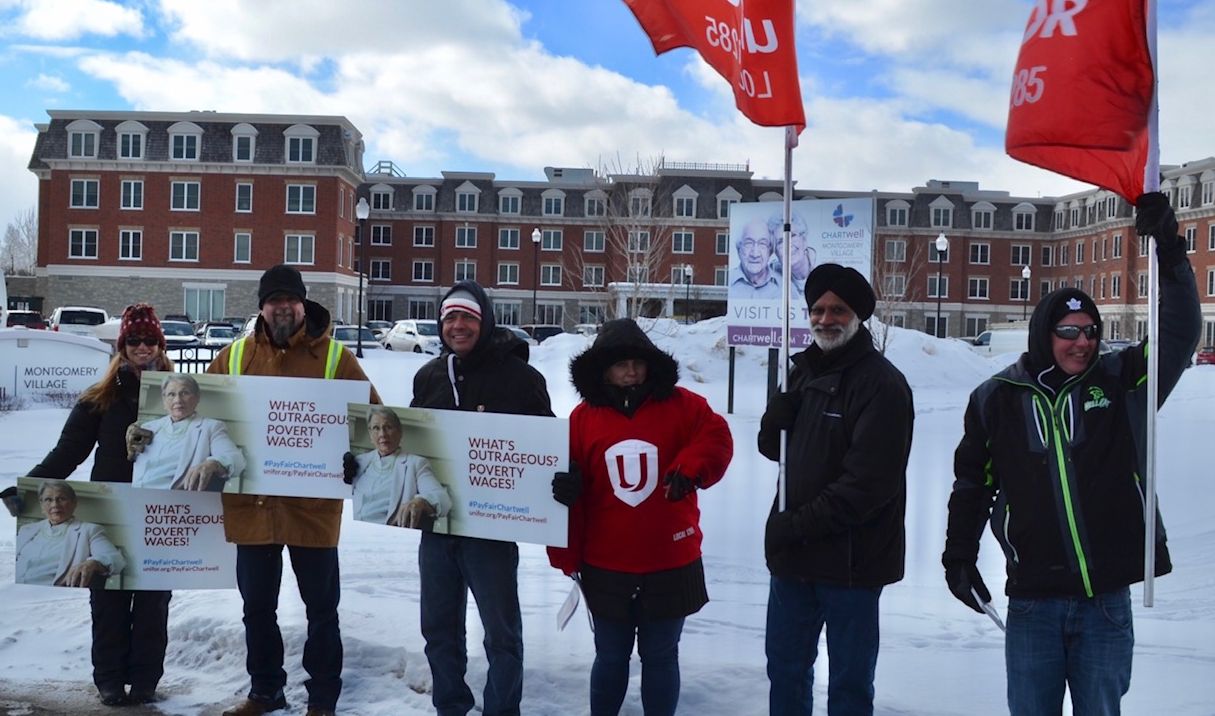Ford and for-profit homes to blame
At the height of the first wave of COVID-19 in Ontario, the Canadian army released a searing report of what the troops found when deployed in some of the worst affected long-term care (LTC) homes. Nearly 77 percent of total COVID-19-linked deaths in the province were residents in LTC, according to the Ministry of Health. The death and misery had been developing for years
At the time, we wrote : “Cockroaches, rotten food, patients with ulcers left bed-bound, staff moving from unit to unit wearing contaminated gear, staff afraid to ask for supplies for fear of increasing the costs to the home. Those were just some of the disturbing conditions detailed in a Canadian Armed Forces report based on the observations of its members at five Ontario long-term care homes deemed by the province to have required the most support. Over 1,675 troops were brought in to backstop these homes in the last week of April. The allegations paint an appalling picture of residents being bullied, drugged, and left for hours and days in soiled bedding. Of the five homes in question, four were for-profit institutions.”
Commission delivers interim report
In response to the scandal in LTC, the Ford government, in the time-honoured fashion of kicking the can down the road, appointed a commission to investigate the situation and make recommendations. An interim report was delivered on October 22. The main recommendation from the Commission was to back long standing, previous calls for a minimum of four hours of daily care per resident (two hours and 45 minutes of care is the current daily average) and more full-time staff. Acknowledging a previous government report from July 2019 which called for “urgent” hiring to ease long-standing staff shortages that had plagued nursing homes before COVID-19 hit, Chief Commissioner Marrocco stated bluntly that “further ‘study’ of the study is not necessary. What is required is the study’s timely implementation.”
Yet the Ford government did indeed think further study was necessary. The Long-Term Care Minister in the Ford government intoned “we are carefully reviewing each of the recommendations.” And she added that a staffing strategy would be released later this year. Neither would Ford himself commit to the four hours of daily care, contenting himself with a typical Fordism: “we are working day in and day out” to improve conditions in nursing homes. This pronouncement was made on a day that cases in LTCs were steadily rising, with another 37 residents and 11 staff testing positive with three deaths.
“We have heard that LTCs were forgotten in the initial provincial plans to control the spread of COVID-19 until residents started dying,” the commissioners wrote in one of their most pointed comments after hearing submissions from more than 200 people and groups.
Other recommendations included improved infection prevention and control with a dedicated staffer in charge, more inspections of those measures, early interventions by hospitals in nursing homes facing outbreaks of COVID-19 and contingency plans to move infected residents to hospitals or other locations to better control the spread of the virus, particularly in older long-term-care facilities. Not costing too much money, many of these recommendations are already being implemented. However, the sticking point was on the four hours of daily care which would require the hiring of thousands of new personal support workers (PSWs) at a cost of billions of dollars. Ford did offer a band-aid solution in the meantime – effective on October 1, the province provided a “temporary” wage increase of $3 an hour for PSWs who deliver publicly funded services. The key word is “temporary” – it only lasts until March 2021. In other words, it’s on a par with the “hero pay” that grocery workers got in the early stage of the pandemic.
The government finally committed on November 10 to the four hours of direct care every day. But note that this is not for the here and now – the target for implementation is not for this year or next, it’s for 2024-2025.
For-profit homes remain the main problem
In May, the provincial NDP revealed: “Since the pandemic began, the big three for-profit long-term care corporations have hired close Doug Ford allies to protect their financial interests by lobbying Ford and his government. Since the pandemic began, at least four top Ford allies and senior staffers have registered to lobby the government on behalf of the big three: Extendicare, Revera and Chartwell. Private for-profit long-term care corporations continue to post annual revenues of hundreds of millions of dollars during the COVID-19 pandemic.”
In the period of March to April, around half of all Ontario’s care homes had COVID-19 outbreaks and close to a hundred had deaths, with for-profit facilities having a death rate nearly three times that of municipally owned homes. Seven months later, fully into the second wave of the pandemic, nothing has changed. The Toronto Star of November 13 reported: “Residents of Ontario’s for-profit long-term-care homes are still experiencing significantly worse COVID-19 outcomes, both cases and deaths, than those living in municipal or non-profit facilities. According to available data on Ontario’s second wave, the province’s long-termcare facilities are experiencing COVID-19 outbreaks at about the same rate, regardless of whether they’re run by for-profit corporations or not. But once the virus arrives, for-profit facilities have fared far worse – much as they did during the first wave of COVID-19 infections that swept through Ontario nursing homes in the spring.” It turns out that residents in for-profit homes have been more than three times as likely to catch COVID-19 as those in a non-profit facility, and for-profits have seen more than twice as many staff infections per bed. Resident deaths have been far more common.
The Star quoted Dr. Amit Arya, a palliative care physician specializing in long-term care, who witnessed the ravages of the first wave while working in facilities in Greater Toronto. “It’s like a nightmare that we’re reliving now which we really shouldn’t have had to, given that we had months to prepare over the summer for a second wave. Now is the time for us as a society and for our governments to actually bring long-term care into the public system and hold the for-profit sector accountable.”
Studies have shown that, for years, privately owned LTCs have suffered from lower levels of staffing and lower wages. An analysis of union staffing data found that Ontario’s for-profit homes employ 17 percent fewer full-time and part-time workers, on average, than non-profit and municipal homes, based on pre-pandemic staffing levels.
All long-term-care facilities receive provincial government funding using the same formula, to cover the costs of all nursing and personal care. Public and non-profit homes receive some additional funding from municipal taxes. Charges for accommodation are paid by the resident, although the provincial government subsidizes that up to $1,848.73 per month for low-income residents.
The for-profit facilities often charge $2,000 to $4,000 a month and some go up to $7,000. They may use the money for better food but a lot of it goes on the fancy look of the building, cosmetic appearance, glossy brochures, etc., all of which gives the impression of better care, when in reality they do not use this money to cover the care. All homes have the same money for care. The public sector does a better job on staff and care; the evidence of COVID proves the private sector does worse. The private sector is run to provide profits for shareholders and high pay for the senior executives off the back of low paid workers and suffering patients. While bad at care, the for-profit homes are very successful at extracting profit. Over the past decade, the three large private companies paid out $1.5 billion in dividends and $138 million in executive pay.
Taking care of business
Bill 218, titled The Supporting Ontario’s Recovery Act but better named as protecting Ontario’s Businesses Act, is likely to become law in the next few days. When enacted, it would provide broad protections to individuals, corporations and the Ontario government from COVID-19 exposure-related lawsuits. Claims based “directly or indirectly” on an individual being potentially infected with or exposed to COVID-19 are barred if the defendant acted in accordance with applicable public health guidance and laws or made a good faith effort to do so. In other words, if a care home followed procedures regarding PPE and hand washing, a lawsuit would likely be dismissed. “Gross negligence,” however, is not exempt. A legal interpretation of gross negligence is that it “requires a higher level of misconduct than ordinary negligence. Gross negligence has been defined by the Supreme Court of Canada as a very marked departure from the required standard of care.” In the context of COVID-19, “the vast majority of business operations that implemented measures with the intent of following public health guidance, even if those measures were insufficient, would not be found to have been grossly negligent.” In other words, if your loved one died at one of these homes, you’re sh*t out of luck.
A new type of corporate ownership
Evidence that capitalism has its sights on the long-term health sector comes from a Toronto Star investigation published on November 16. “At the Bay Street private equity firm, it’s known as the Ontario-focused investment fund. Inspired by a powerful demographic trend, Arch Corporation’s current venture aims to ‘generate stable long-term cash returns.’” Basically, they’re saying there are more seniors in the population who are living longer and alone but have quite a bit of money to spend on being looked after. These “cash returns” are made by cutting corners on care and staff. As the unions in the LTC sector point out, “business-focused homes cut costs by using part-time staff, rationing products or scrimping on laundry services.”
The Star continues: “While companies such as Chartwell or Revera have for years dominated the private sector of long-term care in Ontario, owning and operating dozens of homes, a new type of corporate ownership has emerged: private companies, like Arch, that buy homes and hire outside management firms to provide the day-to-day care of medically fragile seniors.”
The Socialist Alternative
The horror in Ontario’s long-term care for-profit homes is repeated across Canada. In the first wave, Revera had 230 deaths: the second-most deaths in the industry. The owners have learned nothing since then, and not just in Ontario. Two Revera homes in Winnipeg are the deadliest in the province, totalling 65 casualties as of November 20. l this leads to the conclusion that holding the for-profit sector to account is not enough. The cancer of private ownership needs to be removed altogether from the health system and be replaced with an integrated, publicly owned and run system.
Socialist Alternative Canada says:
- Ensure adequate funding of hospitals and long-term care so that people are treated with dignity and their health needs met
- Fight Privatization – no two-tiered health service.
- End private, for-profit care homes; bring all long-term care into public ownership and control, with compensation only to those in need, not to enrich the owners.
- Prosecute the LTC owners for the needless deaths of residents and staff.
- Immediately raise the wages of all care home workers to union rates of pay.
- Implement immediately a minimum of four hours of daily care per resident in long-term care homes.
- Support the struggle for decent, unionized, well paying jobs in hospitals and care homes, including guaranteed steady hours in only one institution.
- For a socialist society, one that can provide dignified care and treatment for the elderly.




